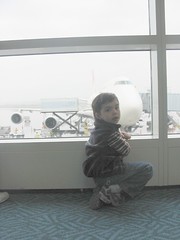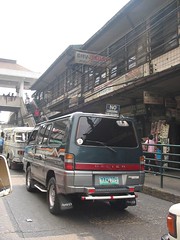First and foremost, for Cheryl’s benefit: Michael slept. However, the boy followed the pace of travel - not the clock.
Our journey began at noon at YVR, Vancouver International Airport, where we stood in line to check our baggage. That is where the ‘hurry-up and wait’ familiar to all travelers began for us.
Then for some reason our aircraft was late coming into Vancouver. That delayed our departure from three o’clock to three-thirty. Michael hopped around like an impatient grasshopper asking when we could get on the plane.

After the plane took off is when the reality of having to stay in one’s seat next to a small boy for over nine hours really hits.
The mind seemingly can comprehend the fact that the Pacific Ocean takes up ¾ of the earth’s surface, but that fact doesn’t really convey the sheer vastness of it. Even flying at ground speeds over 500 mph, it still takes the better part of 9½ hours to cross from Vancouver to Tokyo.
Michael didn’t really cotton onto the fact that the cues around him didn’t jive with his body clock. At 5 hours into the flight, it was 8 pm at home, but the sun was still shining in the windows of the airplane. Michael refused to believe it was his bed-time. So he stayed up and watched the Disney channel on the small LCD monitor installed in the back of the seat in front of him.
We didn’t bother trying to explain to Michael that we were crossing the international date-line – which indicates where the calendar date increases going west or decreases going east. For reasoning adults, it really makes for turning one’s sense of time upside down. For small children, it could simply be another ‘trick’ adults play on one to get one to sleep.
It wasn’t until about the eighth hour of our crossing – around 11 pm Pacific – that Michael finally succumbed to fatigue and went to sleep.
Our tickets were booked with Japan Airlines and throughout our journey our Japanese hosts were professional, courteous, and efficient. I mention this because such cultural discipline only served to sharpen the contrasts I was about to encounter when we stepped out of the plane in Manila.
Before I get into that part of our trip, I have to note here that Narita is huge. After we landed, it was a good 15 minutes of taxiing before our plane actually pulled into the terminal. I know because they show you on the main cabin screens the view from a camera mounted close to the nose wheel and I watched us drive around following a yellow line that twisted and turned enough times in the first 5 minutes that I got totally disoriented.
Our stop-over at Narita was uneventful, except that I was sorely disappointed that the wireless internet access was not free – unlike in Vancouver’s lounges. So I missed my chance to update Cheryl by e-mail that we were progressing well.
It was another 4½ hours to Manila from Tokyo. This time Michael did sleep when we asked him to. After all it was around 3 am in our home Pacific time-zone. We couldn’t get him to wake properly before we landed and for the first time so far, we had a really cranky boy on our hands. I managed to get Michael calmed down enough that we were able to walk off the plane and make our way to where we had to line up for Immigration.
The truly fatiguing part about travel is that you have maintain this sense of alertness while trying to deal with people who are serving you (and often trying to get you to relax) at the same time. The sense of alertness is there to ensure you don’t miss important information that could affect your journey. It’s also there because you’re in an unfamiliar environment and you want to be wary that no one steals your things if you’re not careful.
After twelve hours of travel, being on the jump starts to take its toll on you. Even so, I managed some mental notes of details like the band playing at the airport – welcome to the Philippines – it’s a little different than the sculpture and waterfalls that greet you at YVR. There was also a spot in the passageway where you had to walk across a carpet soaked in stuff to help fight avian influenza.
The heat was not as fierce as I had remembered. The difference I suppose was that we arrived in early April and not in July as we had on my last visit.
What was the same was the humid tropical smell mixed with dirty diesel exhaust. It’s not completely ubiquitous, but my memory immediately confirmed the scent as associated with the Philippines.
I should not have been surprised, but they separate immigration and customs into two different functions. I say I should not have been surprised given what I already know about the Filipino affection for creating all sorts of official organizations, bureaucracies, and titles. These offices are often at odds, or at the very least redundant and competitive to no one’s benefit.
Immigration was the first step, then baggage claim, then customs. Oddly the custom’s officer processed us through with no duty. I was sure they would have tried to ding us for something, but he pretty much waved us through without so much as a second glance.
A porter then helped us with our cart, loaded to the sky with seven large boxes of stuff my dad and step-mom had brought for family members, as well as our carry on luggage. We crossed the street where the taxis waited for commercial travelers and non-Filipinos who didn’t have family waiting for them. On the other side we went down a long ramp to meet the chaos that is the Philippines.
If you don’t know anything about the Philippines, you should first understand that it is known as the crossroads of the Pacific, and for good reason. Filipino culture is a unique blend of east, west, mainland, island, ancient, and modern cultures. On the surface the pop-culture influences from Asia and America are immediate and apparent. Below the surface, Filipino philosophy is one based on borrowing ideas and spicing them up.
Stand in the pick-up area at Ninoy Aquino International Airport for five minutes and it’s immediately apparent that Filipinos love their cars. It’s a car culture that encourages decorative modifications far beyond some of the excesses seen here in the U.S. or Latin America.
My step-mom’s nephew picked us up in a late-model van made by KIA that will never see North American shores. It was spacious, functional, and would absolutely fail any American or European crash tests it would be subjected to. It had room for all of the boxes plus our luggage, and still had two rows of bench seats with leg room to spare. It had a solid transmission and a reasonable amount of power. Frankly I wish I could bring one home with me.

As we pulled out of Manila, I noticed a number of things about the highways and byways that probably aren’t news to those of you who have traveled in Asia or Latin America.
Filipinos run 4 or 5 lanes where we would only run 3.
Lane indicating lines are merely descriptive, not prescriptive – even the center lines dividing the flow of traffic in opposite directions. Think of it like this: imagine what driving would be like if counter-flow lanes were implemented ad hoc at the discretion of each driver.
There are no shoulders – or if they are, they’ve been co-opted as an extra lane and also as an area for street vendors to set up their stands.
The concept of zoning doesn’t exist. Houses, factories, and retail shops all co-exist in the same space.
There are no maximum or minimum speed limits. Late model BMW’s or Lexus sedans share the roads with pedi-cabs, motorized tricycles, and the ubiquitous jeepneys. This means that all highways are the equivalent to our secondary roads in North America.
We left Manila at 11:30 at night, and because of the flow of traffic, we only averaged about 50 km/h. It took us 6 hours to travel the 300 kilometers from Manila to Baguio. I was told later that daytime traffic is about half as slow as night time traffic.
As far as pop-culture goes, we listened to Garth Brooks almost all the way up to Baguio. I noticed local franchises for KFC, Burger King, 7-Eleven, and McDonalds. We also passed a Pepsi-co bottling plant.
Thankfully Michael slept through pretty much all of the trip up to Baguio. I slept for most of the way, but woke for the last leg where we left the coastal plain and started climbing through the foothills and then the mountain ridges up to Baguio.
I should have slept as I probably wouldn’t have had any nightmares that were as harrowing as the drive up that old highway – what was probably originally a cattle trail.
At this point my notes end. There wasn’t much more to describe owing to the early morning darkness. We pulled into the town of my birth just as the sun was rising and the roosters started to crow. After traveling across the Pacific at around 800 km/h for the better part of a day, and then traveling less than 1/10th that speed for another six hours, I was glad the journey was almost over as my legs were pretty cramped by then.


1 comment:
I could just imagine myself with you; the great anticipation of how the Phil. looks like since I left in May 1972.
Post a Comment